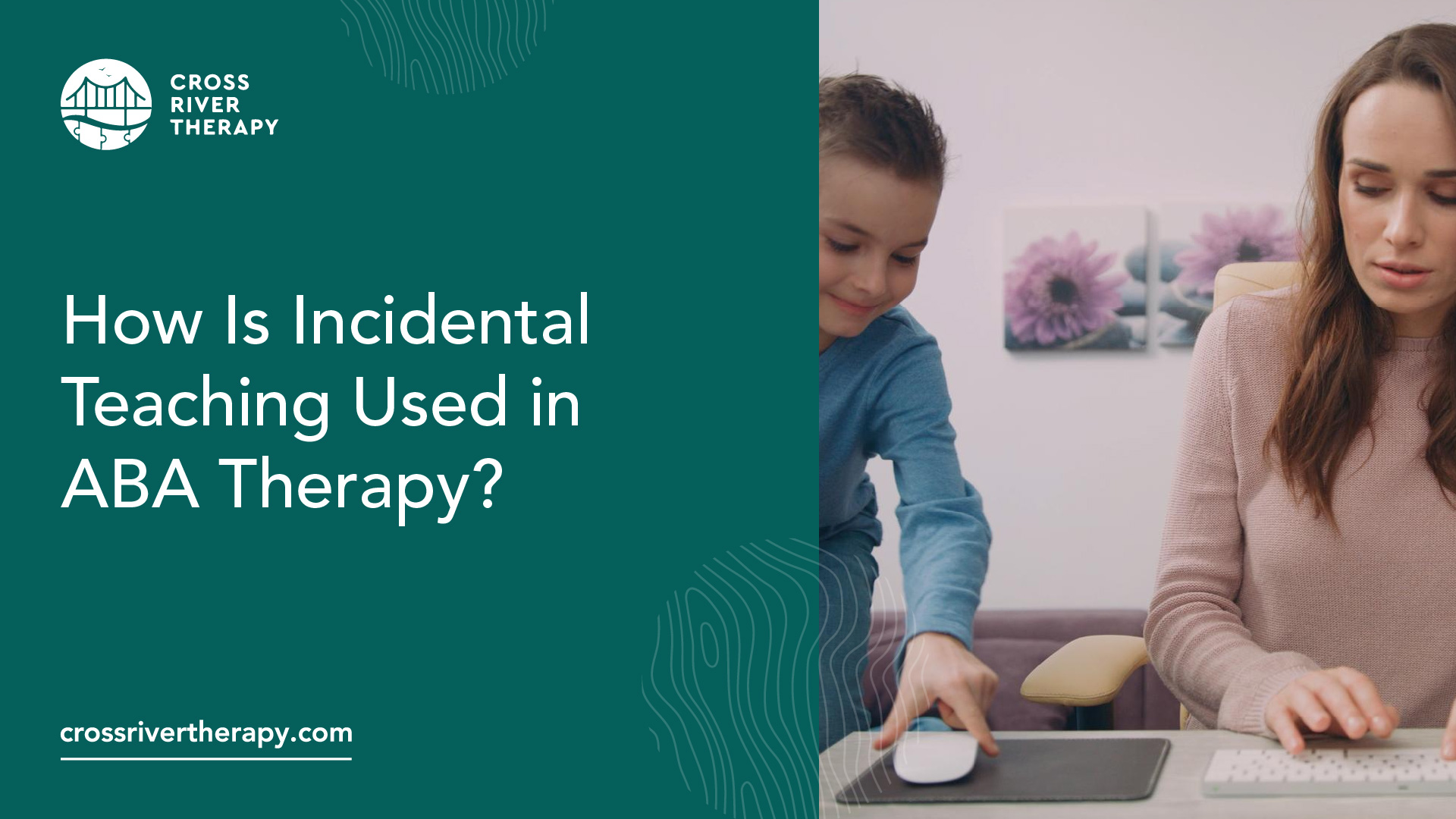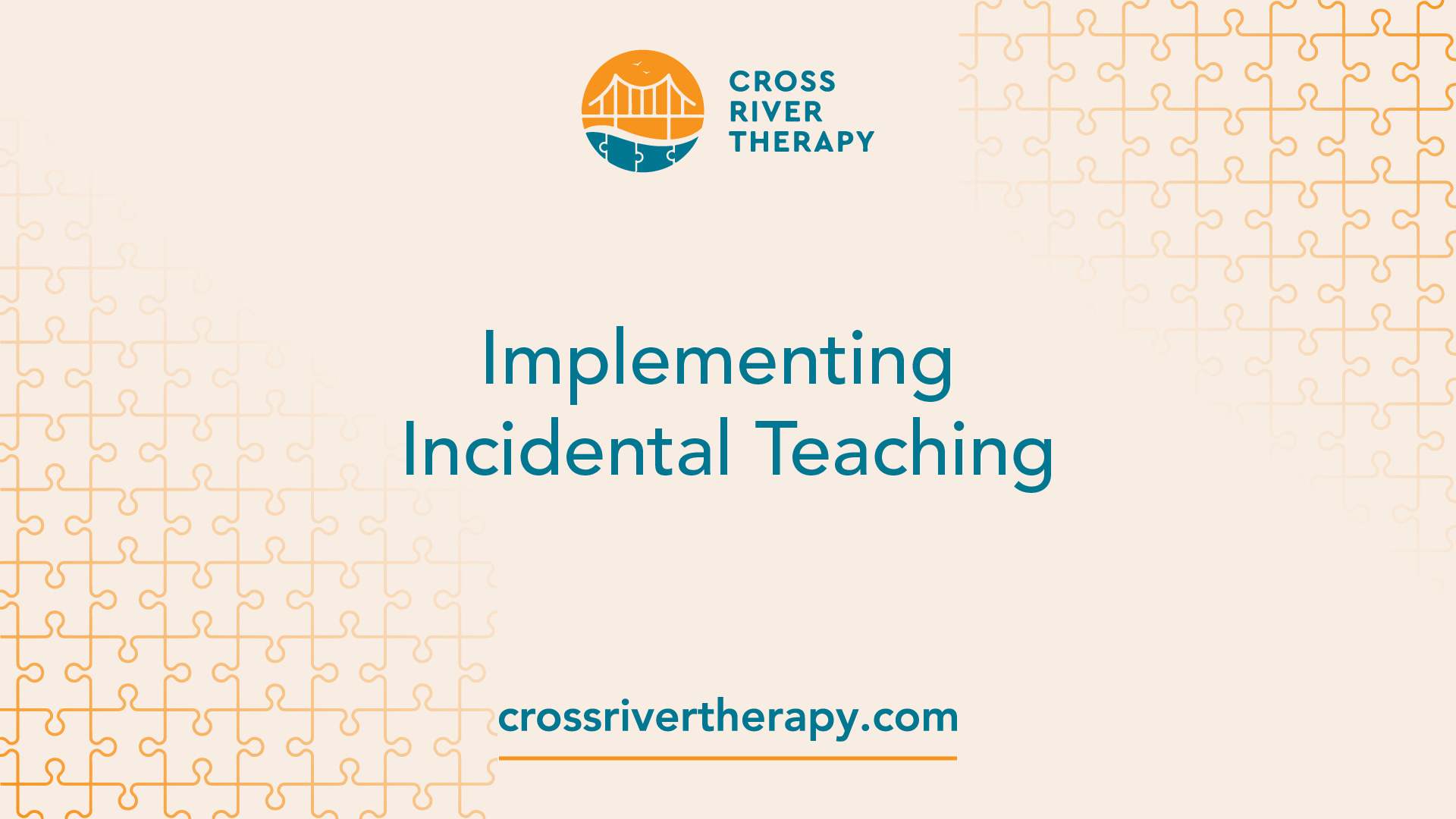How Is Incidental Teaching Used in ABA Therapy?
Discover naturalistic strategies for fostering independence in children with autism.

Understanding Incidental Teaching
Incidental teaching is an approach to learning that focuses on embedding educational opportunities within the natural environment. It emerged as a collaborative effort between behavior analysts, educators, and researchers in the 1970s, aiming to create a more natural and child-centered approach to learning. By taking advantage of everyday situations and activities, incidental teaching promotes skill development and learning in a context that is meaningful and relevant to the individual.
Origins of Incidental Teaching
The roots of incidental teaching can be traced back to the field of early childhood education. It was developed as a response to the limitations of traditional teaching methods and the need for a more child-centered approach to learning. By capitalizing on naturally occurring opportunities, incidental teaching allows for teaching moments to arise naturally rather than relying on a structured and direct teaching approach. This approach recognizes the importance of individual interests and motivations in promoting effective learning.
Application in ABA Therapy
Incidental teaching has found its application in the field of Applied Behavior Analysis (ABA) therapy. It aligns with the principles of ABA therapy by focusing on individualized instruction, reinforcement, and the use of naturalistic teaching strategies. Incidental teaching is widely applied in various settings, including schools, clinics, and home-based interventions, to promote skill acquisition and enhance the generalization of skills.
In ABA therapy, incidental teaching aims to facilitate naturalistic learning experiences, foster independence, and promote self-initiation in individuals with developmental disabilities. By creating an environment that supports learning within the individual's natural context, incidental teaching maximizes the opportunities for skill development and generalization. It allows for learning to occur in a way that is engaging and meaningful to the individual, leading to more effective and long-lasting outcomes.
By understanding the origins and application of incidental teaching, parents and caregivers can appreciate the benefits of this approach in promoting naturalistic learning experiences and fostering independence in individuals with autism. In the following sections, we will explore the specific benefits, strategies, and components of incidental teaching in more detail.
Benefits of Incidental Teaching

When it comes to ABA therapy, incidental teaching has proven to be a valuable approach in promoting learning and development for individuals with autism. This method goes beyond traditional teaching by creating naturalistic learning experiences and fostering independence and self-initiation.
Naturalistic Learning Experiences
Incidental teaching in ABA therapy promotes naturalistic learning experiences, which mimic real-life situations and environments. By incorporating everyday activities and interests, individuals with autism can learn and practice skills in a context that is meaningful to them. This approach helps to enhance the generalization of skills, allowing individuals to apply what they have learned in therapy to various settings and situations.
By providing opportunities for learning in natural environments, such as home or community settings, incidental teaching enables individuals to develop skills that are relevant to their daily lives. This approach encourages a deeper understanding of concepts and enhances the transfer of skills to real-world situations. By engaging in naturalistic learning experiences, individuals with autism can develop a broader range of skills that can be applied across different contexts.
Fostering Independence and Self-Initiation
One of the key benefits of incidental teaching in ABA therapy is its focus on fostering independence and self-initiation. This approach encourages individuals with autism to take an active role in their learning process by making choices, solving problems, and initiating interactions and activities based on their interests and preferences [1].
By allowing individuals to have a say in the learning process, incidental teaching promotes autonomy and self-determination. It empowers individuals to take ownership of their learning and become more actively engaged in their therapy sessions. This approach not only enhances motivation and enthusiasm but also promotes the development of important life skills, such as decision-making and self-advocacy.
Through incidental teaching, individuals with autism have the opportunity to practice and apply their skills in a natural and meaningful way. This can lead to greater confidence and independence in various areas, including communication, social interactions, and problem-solving. By fostering independence and self-initiation, incidental teaching contributes to the overall growth and development of individuals with autism.
Incorporating incidental teaching into ABA therapy provides numerous benefits, including naturalistic learning experiences and the promotion of independence and self-initiation. By creating a supportive and inclusive learning environment, individuals with autism can thrive and develop the skills they need to navigate the world around them.
Implementing Incidental Teaching

To effectively implement incidental teaching in ABA therapy, it is essential to utilize specific strategies and create meaningful learning experiences. By doing so, individuals can benefit from naturalistic learning experiences and develop independence and self-initiation skills.
Strategies for Effective Implementation
Implementing incidental teaching within the ABA therapy setting requires careful attention to the environment and the use of specific strategies that capitalize on the individual's interests and motivations. Here are some strategies that can help facilitate effective incidental teaching:
- Follow the learner's lead: Observe the learner's interests and join in their activities to create opportunities for teaching. By engaging with activities that naturally capture their attention, you can effectively introduce new skills and encourage learning.
- Wait for the learner to initiate: Encourage the learner to take the lead and initiate interactions or activities. By allowing them to initiate, you promote their independence and self-initiation skills. This approach also helps build their confidence and motivation to engage in learning.
- Provide choices: Offer the learner choices within the context of their activities. This empowers them to make decisions and fosters their decision-making skills. By incorporating choices, you increase their sense of control and engagement in the learning process.
- Expand on the learner's interests: Once the learner shows interest in a particular activity or topic, expand on it by introducing related concepts or skills. This helps to broaden their understanding and promotes generalization of skills.
Creating Meaningful Learning Experiences
Meaningful learning experiences are crucial for successful incidental teaching. By tailoring instructions to the specific needs and interests of the learner, you can enhance their engagement and promote effective learning outcomes. Here are some ways to create meaningful learning experiences:
- Use real-life situations: Incorporate everyday situations and activities into the learning process. This allows the learner to practice skills in relevant contexts and facilitates the transfer of learned skills to their daily life.
- Promote communication and social skills: Encourage meaningful interactions, turn-taking, and problem-solving during incidental teaching sessions. This helps develop communication and social skills by providing opportunities for the learner to engage in naturalistic conversations and social interactions.
- Provide scaffolding: Offer support and guidance as needed, gradually reducing assistance as the learner becomes more independent. Scaffolding involves providing prompts, cues, or hints to facilitate learning. However, it is important to fade these supports over time to promote independent problem-solving and skill acquisition.
By implementing effective strategies and creating meaningful learning experiences, incidental teaching in ABA therapy can promote generalization of skills, increase independence and self-initiation, and enhance communication and social skills. It provides individuals with opportunities to practice skills in real-life situations and transfer them to everyday life.
For more information on ABA therapy and other related topics, you can explore our articles on ABA therapy and inclusion strategies, ABA therapy for behavioral interventions, and ABA therapy for community skills.
Incidental Teaching in Natural Environments
In the context of ABA therapy, incidental teaching is often implemented in natural environments to facilitate meaningful and relevant learning experiences for individuals with autism. This approach aims to create an environment that closely resembles everyday situations, promoting generalization of skills beyond structured teaching sessions. Two key components of incidental teaching in natural environments are Natural Environment Teaching (NET) and child-initiated interactions.
Natural Environment Teaching (NET)
Natural Environment Teaching (NET) is a fundamental component of incidental teaching in ABA therapy. It involves creating a learning environment that resembles natural, everyday situations rather than relying solely on structured teaching sessions. By incorporating learning into routine activities, such as playtime and mealtimes, NET promotes learning in a context that is relevant and meaningful to the individual.
NET allows for the integration of various skills, such as verbal expressive language, social responsiveness, imitation, and independence in daily living, into the individual's daily routines. This approach helps to enhance engagement and responsiveness, making the learning process more enjoyable and effective. Research indicates that incidental teaching in natural environments is particularly beneficial for children with language and communication delays, including those on the autism spectrum, as it supports their ability to transfer learned skills into new settings and build social interactions [3].
Child-Initiated Interactions
Child-initiated interactions are another crucial aspect of incidental teaching in natural environments. This approach involves following the child's lead and capitalizing on their interests and motivations to create learning opportunities. By allowing the child to initiate interactions and activities, therapists and caregivers can provide targeted prompts and reinforcement to facilitate skill development.
Child-initiated interactions promote independence and self-initiation, as the child takes an active role in determining the direction of the learning experience. This approach fosters engagement and allows the child to feel empowered, increasing their motivation to learn and participate in meaningful activities. Through child-initiated interactions, individuals with autism can develop a range of skills, including communication, social interactions, problem-solving, and adaptive behaviors.
By employing incidental teaching in natural environments, ABA therapy aims to create a holistic and comprehensive learning experience for individuals with autism. This approach recognizes the importance of embedding skills within the individual's natural routines and activities, promoting generalization and meaningful application of learned skills.
Key Components of Incidental Teaching
When utilizing incidental teaching in ABA therapy, there are two key components that play a vital role: prompts and reinforcements.
Prompts in Incidental Teaching
Prompts serve as cues or instructions provided to assist the child in completing a specific task. They are used to guide the child's behavior and help them achieve the desired outcome. In incidental teaching, prompts are strategically used to prompt the child's response in a naturalistic and unobtrusive manner. The goal is to provide just enough support to facilitate learning while gradually fading the prompts as the child becomes more independent.
There are various types of prompts that can be used in incidental teaching, including:
- Verbal prompts: These involve using verbal instructions or cues to guide the child's behavior.
- Gesture prompts: These involve using gestures or physical cues to prompt the child's response.
- Visual prompts: These involve using visual aids, such as pictures or written instructions, to prompt the child's behavior.
- Model prompts: These involve demonstrating the desired behavior for the child to imitate.
- Positional prompts: These involve manipulating the environment or the child's position to prompt the desired response.
The use of prompts in incidental teaching is carefully tailored to the individual needs and abilities of the child. Prompting strategies are adjusted based on the child's progress, ensuring that they are provided with the necessary support to succeed while gradually promoting independence.
Role of Reinforcements
Reinforcements play a crucial role in incidental teaching, serving as rewards or positive consequences that follow appropriate behaviors. They are used to motivate and reinforce the child's engagement and participation in learning activities. Reinforcements can take various forms, such as verbal praise, tokens, stickers, or access to preferred activities or items.
In incidental teaching, reinforcements are used to reinforce the child's correct responses, appropriate behaviors, and active participation. By providing immediate and meaningful reinforcements, the child is encouraged to continue engaging in the desired behaviors, promoting learning and skill acquisition.
It is important to note that reinforcements should be individualized and tailored to the child's preferences and interests. What may be reinforcing for one child may not be as motivating for another. A thorough understanding of the child's preferences is essential for selecting appropriate reinforcements that will effectively reinforce their engagement and participation in incidental teaching activities.
By utilizing prompts and reinforcements effectively, incidental teaching maximizes the child's learning opportunities and promotes skill acquisition in a naturalistic and meaningful way. The strategic use of prompts provides guidance, while reinforcements motivate and encourage active participation, fostering continued learning and progress in ABA therapy.
Success Stories with Incidental Teaching
Incidental teaching has shown great promise in the field of ABA therapy, particularly for children with autism. Research findings on incidental teaching have highlighted its positive impact on learning and development, leading to real-life success stories.
Research Findings on Incidental Teaching
Studies have demonstrated that children with autism who have undergone incidental teaching have shown an increased ability to transfer what has been taught into new settings and build social interactions. The naturalistic approach of incidental teaching, which focuses on teaching in natural environments such as during play and mealtime, has been found to be more engaging and responsive for children with language and communication delays, including those on the autism spectrum.
Incidental teaching allows educators and caregivers to tailor instructions to the specific needs and interests of the learner, leading to more effective learning outcomes. It promotes communication development by encouraging meaningful interactions, turn-taking, and problem-solving. The Walden Toddler Model, a program in the U.S., utilizes incidental teaching to blend learning into the routine of families of autistic children. The curriculum includes comprehensive training for skills acquisition such as verbal expressive language, social responsiveness to adults, social tolerance/imitation of peers, and independence in daily living [3].
Real-Life Impact of Incidental Teaching
The real-life impact of incidental teaching can be seen in the progress made by individuals with autism who have benefited from this approach. By providing learning opportunities in natural environments and incorporating the child's interests, incidental teaching fosters independence, self-initiation, and generalization of skills. Children who have received incidental teaching have shown improvements in their communication abilities, social interactions, and adaptive skills.
Parents and caregivers have reported significant positive changes in their children's behavior and overall development. Incidental teaching has empowered families to support their children's learning and growth in daily activities and routines. By integrating teaching moments into everyday life, incidental teaching has become a valuable tool that enhances the quality of life for children with autism and their families.
In conclusion, incidental teaching has proven to be an effective and valuable approach within ABA therapy for children with autism. Its naturalistic and individualized nature allows for meaningful learning experiences and promotes skill generalization. Through ongoing research and real-life success stories, incidental teaching continues to make a positive impact on the lives of individuals with autism, supporting their development and fostering independence.
References
[1]: https://www.abtaba.com/blog/incidental-teaching
[2]: https://www.adinaaba.com/post/what-is-incidental-teaching-in-aba-therapy
[3]: https://www.autismparentingmagazine.com/autism-incidental-teaching/
[4]: https://www.autismparentingmagazine.com/autism-incidental-teaching
[5]: https://www.sunbeltstaffing.com/blog/using-aba-therapy-in-school-settings/



